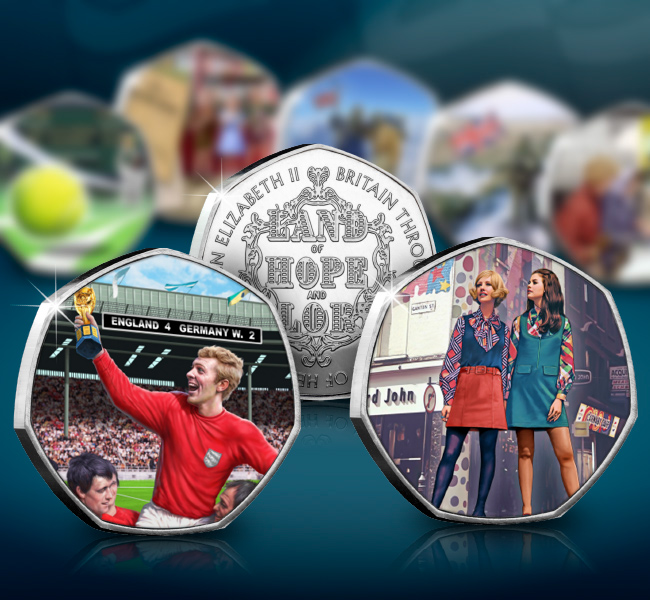Posts Tagged ‘Land of Hope and Glory’
Britain through the reign of Her Majesty Queen Elizabeth II: Part 4
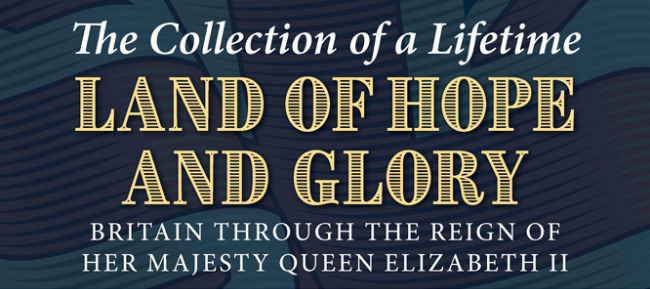
The Land of Hope and Glory Collection tells the story of Britain through the reign of Her Majesty Queen Elizabeth II.
In the final instalment of the series, we will revisit some of the important events that have happened during Her Majesty’s reign in the past three decades.
Fire at Windsor Castle
On the 20th November, 1992 a terrible fire took place at Windsor Castle, the magnificent building Her Majesty the Queen calls home for most of her private weekends and one month a year over Easter.
Maintenance work was being carried out in the Castle at the time when a faulty spotlight overheated leading to it igniting. A nearby curtain took hold of the heat, lighting up in flames.
The fire spread dramatically.
Luckily, due to the work being carried out, much of the furniture which would have been near when the fire started, had already been removed to create space. This meant that a lot of possessions that would have been completely destroyed, were safely tucked away somewhere else.
Those working in the Castle, along with soldiers and members of the Royal family, all formed a human chain to pass items along out of the building. As such this meant that 300 clocks, historic manuscripts, thousands of valuable books, a forty-six-meter-long table, thirty-seven-meter-long carpet, and a collection of miniatures were all rescued.
Help quickly arrived and all together 1.5 million gallons (6,750 tons) of water from the mains water supply, a reservoir fire hydrant, a swimming pool, a pond, and the nearby River Thames were used to stop the fire.
After five years the Castle was returned to its former glory and remains open to the public throughout the year — continuing its 900 years of history today.
To find out more details of booking a visit to the Castle, click here >>
Channel Tunnel Opens
The American Society of Civil Engineers described this as one of the “seven wonders of the world” in 1996. Connecting Britain and the European mainland for the first time ever since the Ice Age, The Channel Tunnel reduced travel time between England and France to a mere thirty-five minutes. At the height of its construction fifteen thousand people were employed and eleven boring machines used. One boring machine is as long as two two football pitches, and all eleven together weighed an enormous twelve thousand tones.
Interestingly, one remains buried under the Channel and another was sold on eBay in 2004 for £39,999!
Her Majesty travelled from Waterloo to Calais on the 6th May, 1994 at a speed of 80 pmh. She joined President Mitterrand, who had travelled from Paris at 186 mph and together they officially opened the Channel, cutting red, white and blue ribbons to the sound of each’s national anthems.
The Angel of the North is constructed
Standing at an impressive sixty-five feet, the impressive Angel of the North is the height of four double decker buses!
In 1994, when winning artist Antony Gormley’s designs were revealed, the public were not too happy with the plans. Causing uproar, materials put forward were frowned upon, along with the size and magnitude of the sculpture in such an open and unlikely place.
However, many years on, those that live near have fallen in love with it. It has become a site of pleasure and this year celebrates its 24th birthday. Made from steel and a small amount of cooper, the Angel is meant to last for more than one hundred years. Coppers slows the erosion of the steel, and the materials together are quite malleable and can be easily manipulated into a variety of shapes and forms. The Angel of the North cost £800,000 to build and is seen by more than one person every second. It represents the history behind the site, societies future and our transition from the industrial age to the information age. An evolving sculpture to evolve with us.
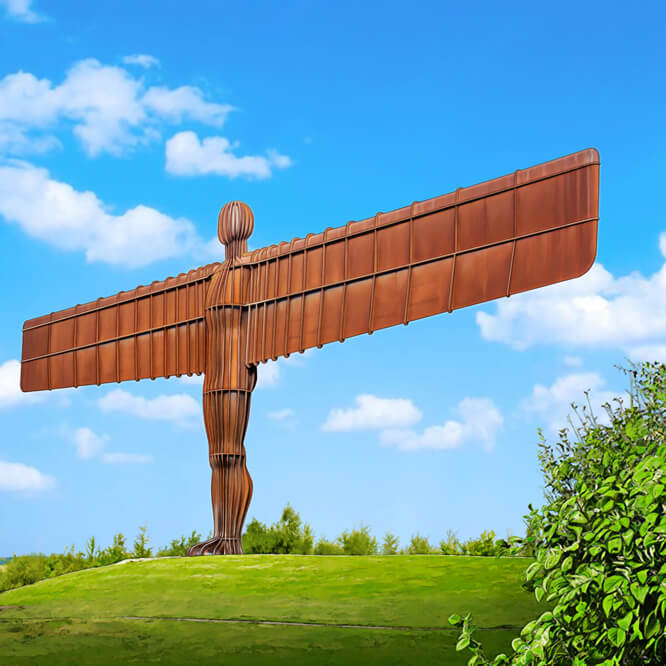
The Millennium Fireworks
The millennium fireworks marked the movement into a new decade. Celebrations were held up and down the United Kingdom, with something for everyone to take part in, and crowds of more than two million took to London.
An incredible firework display took place by the River Thames. Outside of the UK, events were coordinated around the world to see in the new millennium, including an outdoor concert in Washington, United States.
On the Tower Bridge of London Her Majesty Queen Elizabeth II lit a laser which shot fire across the river to the national beacon. This beacon took hold of the fire, signalling the embrace of a new century. Soon after, beacons across the UK all became lit, uniting everyone across England, Wales, Scotland and Northern Ireland. Her Majesty also attended the Millennium Dome in Greenwich which held a special concert.

Birth of Prince George
In 2012, the Duke and Duchess of Cambridge announced that they were expecting their first child. This child would become third in line to the throne and would become a future monarch of the United Kingdom. On 22nd July 2013, Prince George was born at St Mary’s Hospital in Paddington.
Prior to his birth the Queen made some changes which impacted the Bill of Rights (1689) and the Act of Settlement (1701). A new Crown Act (2013) was brought into force which essentially put an end to a younger son displacing an elder daughter in the line of succession to the throne. Prince George is the first to have been born under this act. You can find out more about the line of succession here >>
As is tradition with any Royal birth, the announcement was placed on the easel outside Buckingham Palace. Along with this, many celebrated up and down the commonwealth countries, and certain water features across the globe were illuminated in blue.
This instalment marks the last in our Britain through the reign of Her Majesty Queen Elizabeth II blog series. We hope you have enjoyed travelling back with us through the different decades as much as we have.
If you’re interested…
The Land of Hope and Glory Collection celebrates Britain through the reign of Her Majesty Queen Elizabeth II. And today, you can start the collection of a Lifetime. Click here to secure the Coronation Medal for FREE >>
Revisit the historic moments that have shaped Britain through the reign of Queen Elizabeth II with our Land of Hope and Glory blog series:
Click here to read instalment 1 of the Land of Hope and Glory blog series >>
Click here to read instalment 2 of the Land of Hope and Glory blog series >>
Click here to read instalment 3 of the Land of Hope and Glory blog series >>
Britain through the reign of Her Majesty Queen Elizabeth II: Part 3

The Land of Hope and Glory Collection tells the story of Britain through the reign of Her Majesty Queen Elizabeth II.
Britain goes Decimal…
On the morning of the 15th February 1971, Britons woke up with a brand new currency following increasing global pressure to go Decimal. In one of the biggest changes to our currency in 1000 years, we left behind the old Pounds (£), Shillings (/-) and Pence (d) system and introduced the decimalised coins that we know today.
Under the new system, the Pound was retained, but was divided into 100 new pence rather than 20 shillings (or 240 pence). And to help the public get used to this major change, new Decimal coins, training stamps and conversions charts were all made available to the public ahead of Decimal Day.
Do you still have any of the old pre-Decimal coins? Let us know in the comments
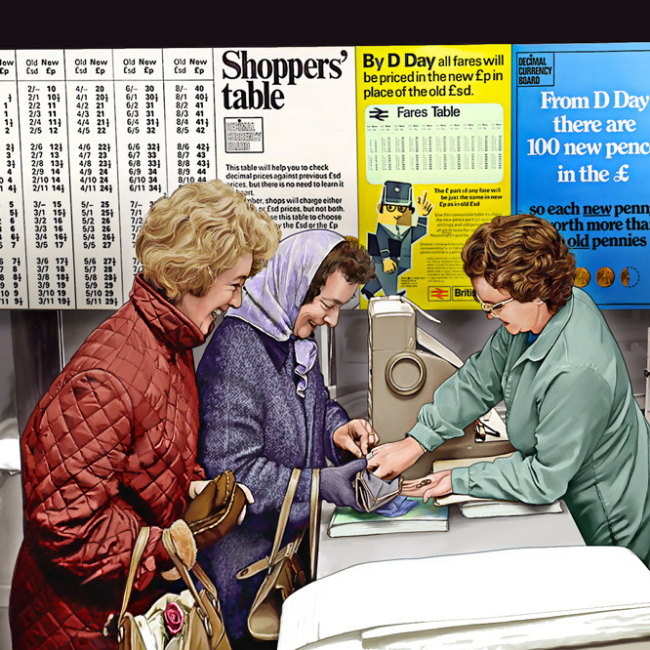
First Test Tube Baby
On 25th July 1978, a five-pound baby girl named Louise Joy Brown was born in Lancashire. As the first baby to be conceived through in vitro fertilisation (IVF), Louise’s birth made headlines and she became known around the world as the first “test tube baby”. A few years later, Louise’s younger sister Natalie was born, also via IVF. And in 1999, Natalie became the first mother born through IVF to give birth – without IVF.
Patrick Steptoe, Robert Edwards and Jean Purdy, the pioneering medical professionals who were involved in Louise’s birth were awarded a Nobel Prize in Medicine for their life-changing work. As of 2022, it has been estimated that over eight million babies worldwide have been conceived via IVF
The Home Computing Boom
1980s Britain saw a boom in home computing and a drastic change in public opinion towards the technology. Once seen as complex machinery used only by scientists and large organisations, computers were rare and most people would have never seen a computer in real life…
Fantastic machines like the Acorn Electron, Commodore 64 and Sinclair ZX Spectrum were developed to make computing user-friendly for the first time and to bring the wonders of information technology into homes, schools and workplaces.
Technology would continue to advance throughout the decade, as the home computing boom caused an unexpected growth in video gaming and by 1989 a British scientist, Tim Berners Lee, conceived and developed the World Wide Web.
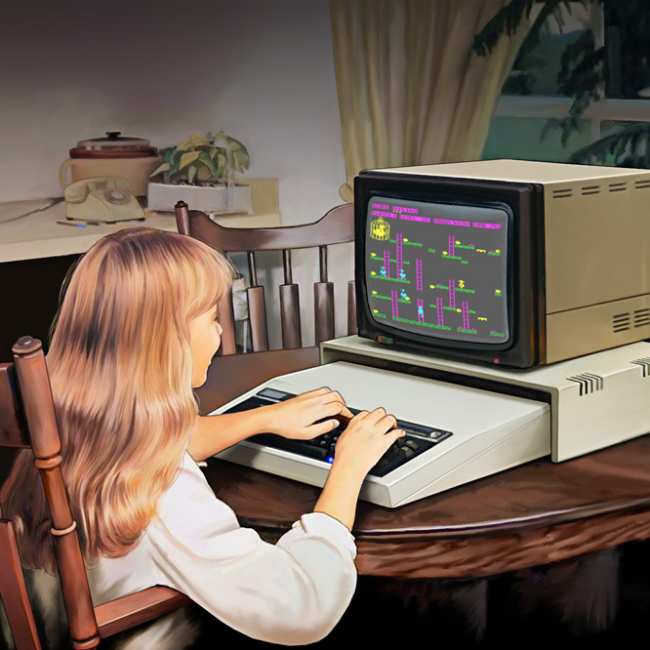
The Wedding of Prince Charles and Lady Diana Spencer
Described at the time as a “fairytale wedding”, Prince Charles and Lady Diana Spencer were married at St Paul’s Cathedral on 29th July 1981. The event was watched by a record-setting global television audience of 750 million, all eager to see Diana’s wedding dress which was one of the best kept secrets of the fashion industry at the time.
Were you one of the 750 million to watch?
The wedding broke royal protocols and created traditions that we still see during Royal Weddings today. Diana was the first Royal bride to omit the words “obey” from her vows and after forgetting to kiss after their vows, the couple shared a romantic kiss on the balcony of Buckingham Palace. Today, the ‘balcony kiss’ is one of the most iconic moments to take place during a Royal wedding.
The Raising of the Mary Rose
The Mary Rose was lost for over 400 years. She was one of Henry VIII’s warships and a huge team of divers, archaeologists and scientists were involved in her recovery and raising.
The search for the Mary Rose began in 1965, when Alexander McKee began investigating wrecks in the Solent and discovered a strange shape underneath the seabed via sonar scans. Teams of amateur and professional divers explored the area and on 5th May 1971, Percy Ackland found three of the port frames of the Mary Rose.
Nearly 11 years of excavation and careful planning followed and finally, on 11th October 1982, the world watched the raising of the historic Mary Rose…
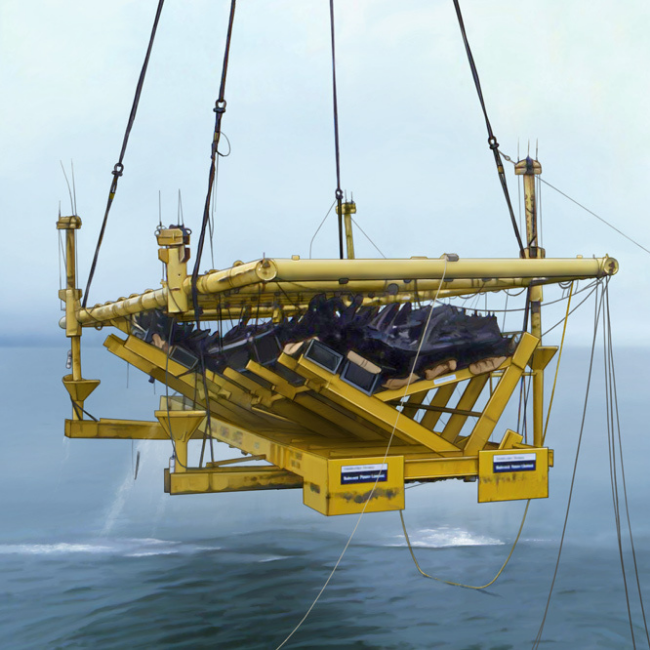
If you’re interested…
The Land of Hope and Glory Collection celebrates Britain through the reign of Her Majesty Queen Elizabeth II. And today, you can start the Collection of a Lifetime. Click here to secure the Coronation Medal for FREE >>
Revisit the historic moments that have shaped Britain through the reign of Queen Elizabeth II with our Land of Hope and Glory blog series:
Britain through the reign of Her Majesty Queen Elizabeth II: Part 2

The Land of Hope and Glory Collection tells the story of Britain through the reign of Her Majesty Queen Elizabeth II. As Queen Elizabeth II’s Platinum Jubilee fast approaches, this blog series will revisit the historic moments during Her Majesty’s record-breaking reign that have helped define Great Britain. This week, let’s journey back to 1960s football, fashion and more.
Did you know that instant potato, the mash you buy pre-made at the supermarket, wasn’t a shop bought item until 1968? Angel Delight made its debut in 1967 and spreadable margarine wasn’t a thing before 1969!
Many do reminisce on the 60s as the time to be alive.
Swinging Sixties Fashion
In the early 60s, the emergence of supermodels like Twiggy and Jean Shrimpton redefined beauty and became true fashion icons. The latest clothing styles could be found in London Boutique shops. And whilst children began to practice with makeup on their dolls, teenagers discovered false eyelashes.
Inspiration came from the likes of the mods on scooters, skinheads, and hippies with their long flowing hairstyles.
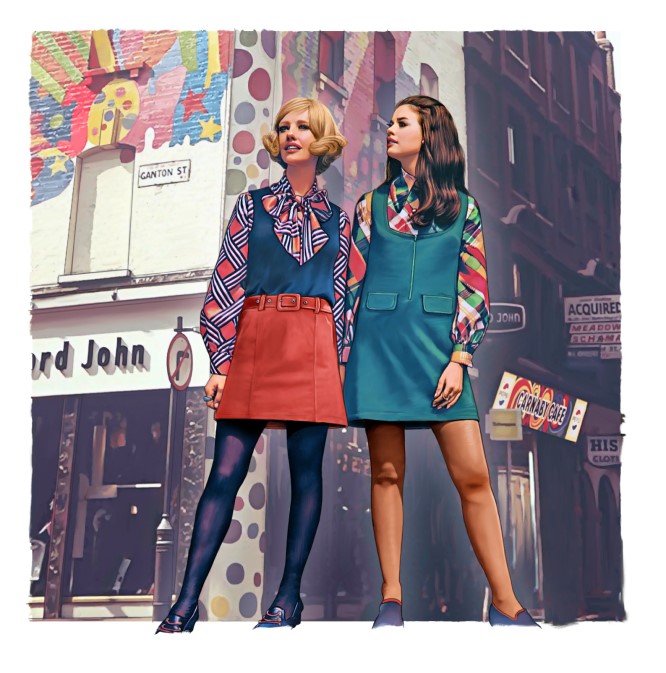
Mary Quant, the queen of the miniskirt, had a boutique on Carnaby Street in London called Bazaar. She also released her own line of cosmetics in 1966. Many began to embrace their natural curves — new trends such as wearing trouser suits and miniskirts emerged.
England wins the FIFA World Cup
The TV audience in 1966 had to follow along the England match against Germany in black and white. However, for the first time they could see slow motion replays from the live match.
Multiple towns in England hosted games for the tournament, but the final was played at Wembley Stadium on the 30th July 1966.
Although the match didn’t get off to a good start and there were a few hiccups throughout, the team managed to bring home the first World Cup title for England.
Her Majesty the Queen and HRH Prince Philip were amongst the 93,000 spectators. The Queen then presented the trophy for the 1966 FIFA World Cup.
The shot by Geoff Hurst, which hit the crossbar and landed down near the goal line, was decided by the referee as a goal — which was highly contested at the time.
Years later, technology had advanced, and the ball was never over the line.
Beatlemania
The Beatles.
Need we say more?
Comprised of John Lennon, Paul McCartney, George Harrison and Ringo Starr, The Beatles were managed by Brian Epstein and signed by EMI on the Parlophone Label.
Did you know that they were originally turned down by Decca, the British record label?
Changing the pop music scene forever, Please Please Me was released January 12th 1963, and was an instant favourite among the public. They remained number 1 on the charts for 6 months with their first album, which was recorded in an entire 13-hour session.
First Flight of the Concorde
Concorde was the first successful civilian aeroplane to travel faster than the speed of sound.
Built jointly between Great Britain and France, it reduced the flight time between London and New York to roughly three hours.
Eventually flown worldwide, she first took to the skies on March 2nd 1969.
Sadly, in the end it was found the aeroplane had several problems such as noise and high expenses. However, it did unify the work of different countries, ensuring that Europe paved the way for aerospace development.
The Great Train Robbery
15 men and £2,600,000. What a heist that is.
Aided by two accomplices, these fifteen men managed to stop the Glasgow–London Royal Mail Train, steal over two and a half million pounds from the front two carriages, and transport the lot with their Land Rovers to a nearby hideaway, all without the staff in the remaining ten carriages even knowing a thing.
August 8th, 1963. The day they got lucky.
It was a bank holiday so the amount they stole was much larger than they had anticipated getting.
At their hideaway they noticed low flying RAF aircraft which they assumed were on the look-out for them. They in fact weren’t. But this spooked the robbers so much that they left and hired six thieves to burn the place down.
The poor job the thieves did left fingerprint marks on a Monopoly board and a ketchup bottle.
If you’re interested…
The Land of Hope and Glory Collection celebrates Britain through the reign of Her Majesty Queen Elizabeth II. And today, you can start the Collection of a Lifetime. Click here to secure the first Medal, featuring the Queen’s Coronation for FREE >>
If you haven’t read the first blog in the series, click here >>


